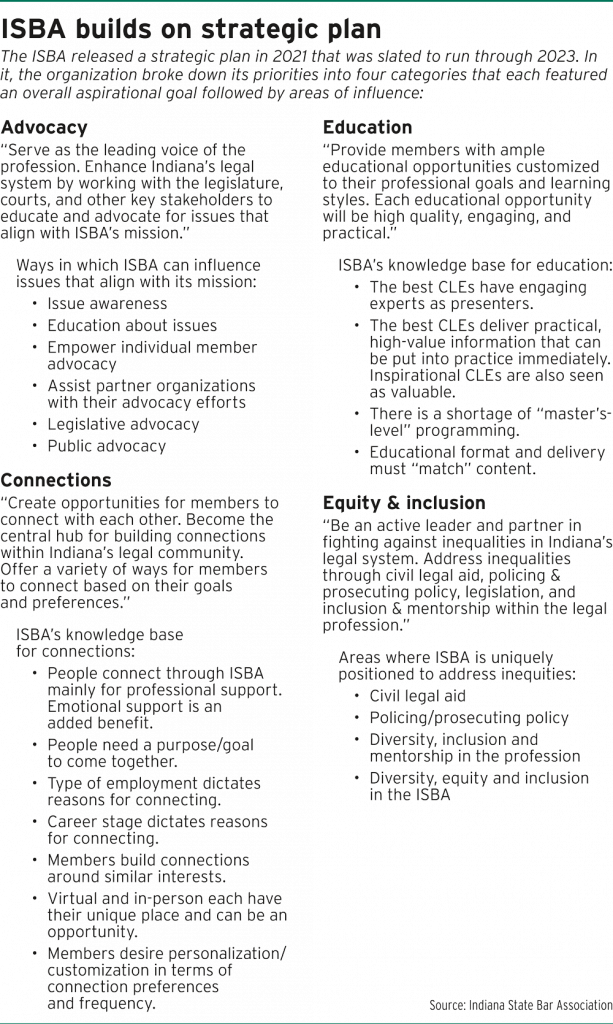Subscriber Benefit
As a subscriber you can listen to articles at work, in the car, or while you work out. Subscribe NowWhen the Indiana State Bar Association unveiled its new strategic plan in 2021, the group had four major areas of focus as it looked to deliver more value to its members: advocacy, connections, education, and equity and inclusion. That plan will technically “end” in 2023, but its principles will have a lasting effect.

Joe Skeel, ISBA’s executive director, said the strategic plan changed a lot of ways the bar association approaches issues with staff, sections and committees. He said the bar wanted to home in on delivering more value to members and did a lot of work researching and collecting data prior to the release of the plan.
“Generally speaking, it’s gone as well as we could have expected, to be honest,” Skeel said, adding that the ISBA has become more strategic and organized as a result.
Kelsey Singh, ISBA’s communication director, said the strategic plan wasn’t so much about what the ISBA thought its members might want, but rather how their needs could be best met by the association.

“It feels like we’re a totally different organization,” she said.
A survey was sent to members to help the bar better understand who its members were, Singh said. The survey went to its roughly 10,500 statewide members in June 2020, asking what was most important to them in their membership.
The plan also included input from member interviews, focus groups, and professionally facilitated conversations with ISBA leaders and staff.
Although the three-year plan — covering 2021, 2022 and 2023 — is slated to end this year, Skeel said he doesn’t view the situation as an end.
Rather, as the bar looks ahead to 2024, 2025 and 2026, he said the plan has laid the groundwork to look at the legal profession and focus on access to justice issues.
What’s in the plan?

Each of the four main sections of the 2021 plan featured an overall aspirational goal followed by areas of influence breaking down how each objective can be accomplished.
Leah Baker, ISBA’s section and committee manager, said the bar association took strategies from the plan and shared them with the association’s sections and committees.
For example, in the connections category, Baker said the ISBA identified a framework in which association programs could be held virtually, in-person or in a hybrid fashion. That was crucial, she said, given the changes that resulted from the COVID-19 pandemic.
“It resulted in virtual programs being utilized more than in-person,” Baker said.
 Another key aspect to the strategic plan was its DEI section. The plan noted that member- and expert-based research identified civil legal aid, policing/prosecuting policy, diversity, inclusion and mentorship in the legal profession, and DEI within the ISBA as areas where the association was uniquely positioned to address inequities in the legal system.
Another key aspect to the strategic plan was its DEI section. The plan noted that member- and expert-based research identified civil legal aid, policing/prosecuting policy, diversity, inclusion and mentorship in the legal profession, and DEI within the ISBA as areas where the association was uniquely positioned to address inequities in the legal system.
Baker said the bar put together a task force to focus on DEI issues.
“They (the task force) ultimately helped us decide where ISBA would have the biggest impact in that area,” she said.
Overall, Baker said the strategic plan guides everything the ISBA staff does internally.
The DEI focus, for example, helps when planning a program, as they try to make it more inclusive and ensure it reaches out to diverse groups within the association.
Baker specifically noted the creation of “Open Conversations: Racism and Racial Injustice,” a bar association program focusing on race and culture in the legal landscape, which started concurrently with the ISBA’s Equity Task Force.
The program has achieved national acclaim, including winning the Association for Continuing Legal Education’s award for outstanding achievement in the public interest category.
“It’s been a really productive and fruitful program,” Baker said.
Looking ahead
The ISBA has a new associate executive director, Carissa Long, and a big reason she was promoted was to carry out the programs in the strategic plan, Singh said. She noted the ISBA is developing programs now that the association created specifically for the different legal professionals in its membership.
For example, Singh said the bar developed an in-house counsel cohort focused on comparing needs of in-house counsel. It also developed a cohort for women associates.
Singh said the programs the ISBA has developed have been popular with members.
“We’re defining success by how impactful it is to each attorney,” she said.
The bar association is now looking at how it can improve the programs it has developed, Singh added.
“So really the strategic plan was a shift in the mindset of our organization,” she said.
The ISBA started planning ahead for the coming years by holding a board retreat in July, according to Skeel. The result was a decision to focus on access to justice issues.
Skeel said three areas the ISBA will be looking at in 2024 and 2025 are the rural attorney shortage in Indiana, nonlawyer ownership of law firms and the paraprofessional “nurse practitioner” model, which some states like Utah and Arizona have made legal.
“The concept is to allow nonlawyers to do some work that has traditionally been limited to lawyers,” he said, noting every state is approaching that issue differently.
As far as access to justice issues, Skeel said if the ISBA can find ways for more people to have access to legal services, it will lower the number of pro se litigants in court. A first step, he said, will be to convene a task force to study those issues.•
Please enable JavaScript to view this content.
